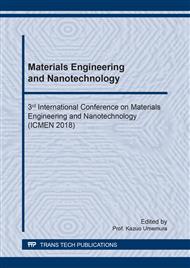[1]
G. P. Ertokus and A. H. Aktas: SDU Journal of Science Vol. 5 (2010), pp.60-66.
Google Scholar
[2]
S. Sakthinathan, S. Palanisamy, S.Chen, P.Wu, L. Yao and B. Lou: Int. J. Electrochem. Sci. Vol. 10 (2015), pp.3319-3328.
Google Scholar
[3]
W. Chan, A. W. M. Lee and M. S. Wong: Microchemical Journal Vol. 40 (1989), pp.322-327.
Google Scholar
[4]
A. Kalijadis, J. Dorsevic, B. Jokic, V. Spasojevic, B. Babic and T. Trtic-petrovic: J. Serb. Chem. Soc. Vol. 82 (2017), pp.1259-1272.
DOI: 10.2298/jsc161228053k
Google Scholar
[5]
M. Gojeh, N. Bahago, Y. Moses, S. Adisu and S. Jabason: Journal of Applied Chemistry Vol. 8 (2015), pp.01-06.
Google Scholar
[6]
M. Zaib and M. M. Athar: Int. J. Electrochem. Sci. Vol. 10 (2015), pp.6690-6702.
Google Scholar
[7]
S.Smarzewska, J. Pokora, A. Leniart, N. Festinger, and W. Ciesielski, Electroanalysis Vol. 28 (2016), pp.1-9.
DOI: 10.1002/elan.201501101
Google Scholar
[8]
I. E. Mülazimoglu, A. D. Mülazimoglu and E. Yilmaz, Desalination Vol. 268 (2011), pp.227-232.
Google Scholar
[9]
I. K. Uskova and O. N. Bulgakova, Journal of Analytical Chemistry Vol. 69, pp.542-547.
Google Scholar
[10]
A. K. Roy, V. S. Nisha, C. Dhand and B. D. Malhotra, J. Mol. Recognit. Vol.24 (2011), pp.700-706.
Google Scholar
[11]
Y. Lv, Z. Lin, W.Feng, and T.Tan, Chromatographia Vol. 66 (2007), pp.339-347.
Google Scholar
[12]
A. T. Aulia, A. Zuhrotul, S. W. Wulan, and N. H. Rizal, Jurnal Penelitian Saintek Vol. 20 (2015) pp.53-60.
Google Scholar
[13]
T. Ito, H. Radecka, K. Tohda, K. Odashima, and Y. Umezawa, J. Am. Chem. Soc. Vol 20 (1998), pp.3049-3059.
Google Scholar
[14]
Y. I. Korenman, T. N. Ermolaeva, and E. A. Podolina, Journal of Radioanalytical and Nuclear Chemisi W, Vol. 228, (1998), pp.113-114.
Google Scholar
[15]
F. Huma, M. Jaffar and K. Masud, Turk J Chem Vol. 23 (1999), pp.415-422.
Google Scholar
[16]
S. Rahmadhani, H. Setiyanto, M. A. Zulfikar, 2017 International Seminar on Sensors, Instrumentation, Measurement and Metrology, ISSIMM (2017), pp.124-128.
DOI: 10.1109/issimm.2017.8124275
Google Scholar
[17]
H. Shekarchizadeh, A. A. Ensafi and M. Kadivar, Materials Science and Engineering Vol. 33 (2013), pp.3553-3561.
Google Scholar
[18]
X. Li, Y. He, F. Zhao, W. Zhang, and Z. Ye, Royal Society of Chemistry Vol. 70 (2015), pp.56534-56540.
Google Scholar
[19]
L. Özcan and Y. Şahin, Sensors and Actuators Vol. 127 (2007), pp.362-369.
Google Scholar
[20]
M. Khasanah, H. Darmokoesoemo, N. M. Sari, Y. Kadmi, H. Elmsellem, and H. S. Kusuma, Results in Physics Vol. 7 (2017), pp.1808-1817.
DOI: 10.1016/j.rinp.2017.05.012
Google Scholar


